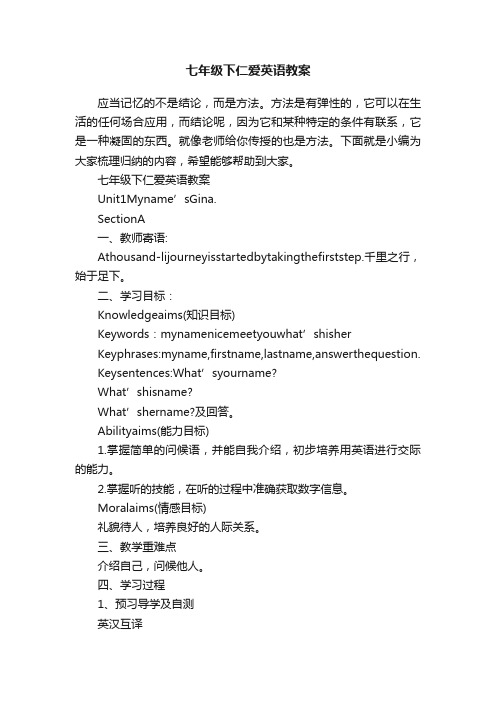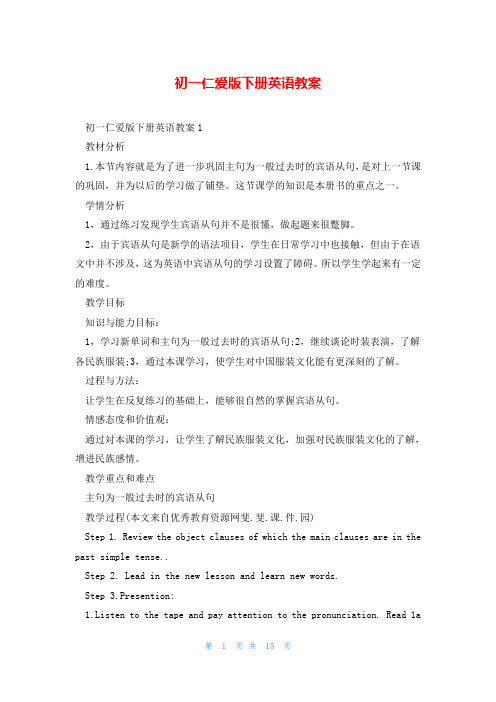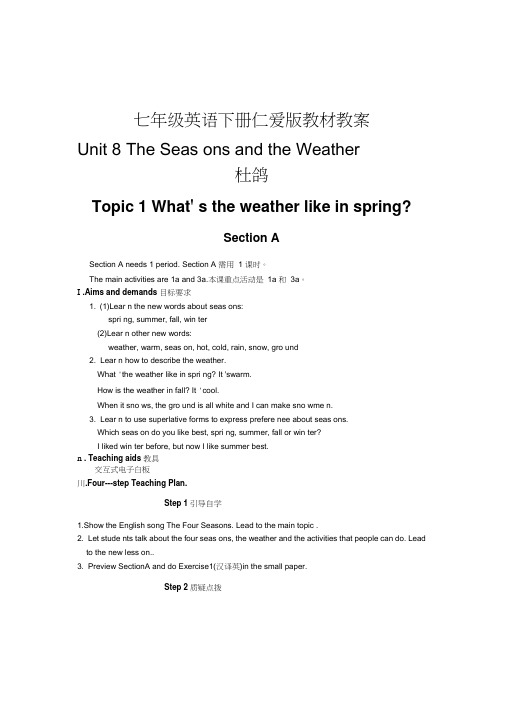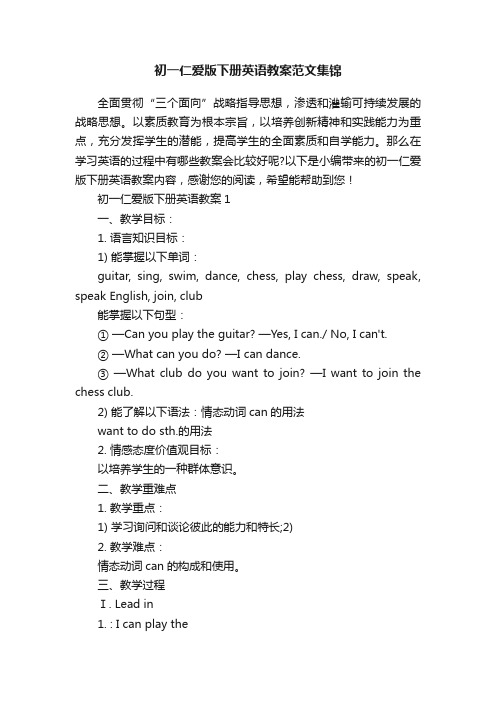仁爱版七年级下教案
七年级下仁爱英语教案

七年级下仁爱英语教案应当记忆的不是结论,而是方法。
方法是有弹性的,它可以在生活的任何场合应用,而结论呢,因为它和某种特定的条件有联系,它是一种凝固的东西。
就像老师给你传授的也是方法。
下面就是小编为大家梳理归纳的内容,希望能够帮助到大家。
七年级下仁爱英语教案Unit1Myname’sGina.SectionA一、教师寄语:Athousand-lijourneyisstartedbytakingthefirststep.千里之行,始于足下。
二、学习目标:Knowledgeaims(知识目标)Keywords:mynamenicemeetyouwhat’shisherKeyphrases:myname,firstname,lastname,answerthequestion.Keysentences:What’syourname?What’shisname?What’shername?及回答。
Abilityaims(能力目标)1.掌握简单的问候语,并能自我介绍,初步培养用英语进行交际的能力。
2.掌握听的技能,在听的过程中准确获取数字信息。
Moralaims(情感目标)礼貌待人,培养良好的人际关系。
三、教学重难点介绍自己,问候他人。
四、学习过程1、预习导学及自测英汉互译_________2.好的,令人愉快的______________3.too___________4.遇见______5.your____________6.his_________7.她的名字______2、自主学习①.onenum.1,一:Oneandtwomakesthree.一加二等于三。
adj.①一个:Ihaveonebook.我有一本书。
②有一(天):Onedayhewillunderstandyou.有一天他会理解你的。
②meet/mi:t/v.遇到,碰到【记忆法】-ee-双写,与meat为同音词。
【考点】tomeetsb.(orsth.)遇到某人/某事:Nicetomeetyou.初次见面时的客套话,不是初次见面时则用see。
初一仁爱版下册英语教案

初一仁爱版下册英语教案初一仁爱版下册英语教案1教材分析1.本节内容就是为了进一步巩固主句为一般过去时的宾语从句,是对上一节课的巩固,并为以后的学习做了铺垫。
这节课学的知识是本册书的重点之一。
学情分析1,通过练习发现学生宾语从句并不是很懂,做起题来很蹩脚。
2,由于宾语从句是新学的语法项目,学生在日常学习中也接触,但由于在语文中并不涉及,这为英语中宾语从句的学习设置了障碍。
所以学生学起来有一定的难度。
教学目标知识与能力目标:1,学习新单词和主句为一般过去时的宾语从句;2,继续谈论时装表演,了解各民族服装;3,通过本课学习,使学生对中国服装文化能有更深刻的了解。
过程与方法:让学生在反复练习的基础上,能够很自然的掌握宾语从句。
情感态度和价值观:通过対本课的学习,让学生了解民族服装文化,加强对民族服装文化的了解,增进民族感情。
教学重点和难点主句为一般过去时的宾语从句教学过程(本文来自优秀教育资源网斐.斐.课.件.园)Step 1. Review the object clauses of which the main clauses are in the past simple tense..Step 2. Lead in the new lesson and learn new words.Step 3.Presention:1.Listen to the tape and pay attention to the pronunciation. Read 1ain different ways to learn it2. Let the students answer some questi. And then fill in blanks according to 1a.Step 4. PracticeLead into Part 2and practice the object clauses of which the main clauses are in the past simple tense.Step 5.Colidation :Step 6.Homework:教学环节一,复习二,导入三,呈现四,练习五,巩固六,作业复习宾语从句,然后利用宾语从句引入新课,并展示图片,学习生词,进而学习少数民族服装,处理第三部分。
仁爱版七年级下册英语教案

仁爱版七年级下册英语教案一、教学目标本节课的教学目标是:1.了解和学习有关健康和健康饮食的词汇和表达方式。
2.能够描述健康和不健康的生活习惯。
3.能够使用所学词汇和表达方式对健康问题进行讨论和提建议。
二、教学重点1.学习与健康和健康饮食相关的词汇和表达方式。
2.能够描述健康和不健康的生活习惯。
三、教学难点1.能够使用所学词汇和表达方式对健康问题进行讨论和提建议。
四、教学准备1.教师准备好与健康和健康饮食相关的词汇和图片。
2.准备课件和板书。
五、教学过程1. 导入新课教师出示一张健康饮食的图片,让学生观察并讨论:“你能看出这个图片里有哪些食物吗?这些食物看起来健康吗?为什么?”引出学习健康和健康饮食的话题。
2. 学习新词汇教师出示健康和不健康的生活习惯的图片,例如晚上早早睡觉、坚持锻炼、多吃水果和蔬菜等,然后带领学生学习并掌握这些新词汇。
单词词性释义healthy adj.健康的unhealthy adj.不健康的exercise n.锻炼fruit n.水果vegetable n.蔬菜3. 练习新词汇教师设计一些练习题,让学生巩固新词汇的记忆和理解。
1.Fill in the blanks.•Eating too much junk food is __________ for your health.•You should do more __________.•Apples and oranges are __________.•Carrots and tomatoes are __________.2.Translate the following sentences into English.•坚持锻炼对保持健康很重要。
•不要吃太多垃圾食品。
•香蕉是水果,洋葱是蔬菜。
4. 综合训练教师给学生提供一些关于健康问题的情景,让学生用所学词汇和表达方式进行讨论,并提出建议。
情景一:你的同学经常晚上玩电脑游戏,睡眠时间很短,经常感到疲劳和头痛。
2024年仁爱版英语七年级下教案【可下载打印】

2024年仁爱版英语七年级下教案【可打印】一、教学内容本节课选自2024年仁爱版英语七年级下册,主要涉及第二章第三节的内容,详细内容包括:一般现在时态的用法,日常作息时间的表达,以及相关词汇和句型的学习。
二、教学目标1. 让学生掌握一般现在时态的用法,并能运用到实际情境中进行交流。
2. 培养学生运用英语表达日常作息时间的能力,增强语言实际运用能力。
3. 通过学习本节课的内容,提高学生的听说读写综合运用能力。
三、教学难点与重点1. 教学难点:一般现在时态的构成及用法,日常作息时间的表达。
2. 教学重点:句型“主语+动词原形/第三人称单数+其他”的运用,以及相关词汇的记忆。
四、教具与学具准备1. 教具:多媒体设备,PPT课件,黑板,录音机。
2. 学具:英语课本,练习册,笔记本,彩色笔。
五、教学过程1. 实践情景引入(5分钟)利用PPT展示不同时间段的图片,引导学生用英语描述图片内容,复习日常作息时间的表达。
2. 例题讲解(10分钟)讲解一般现在时态的用法,通过例句展示,让学生理解和掌握该时态的构成及用法。
3. 随堂练习(15分钟)课堂互动,让学生分组进行对话练习,用一般现在时态描述日常作息时间。
4. 巩固环节(10分钟)利用练习册上的题目,让学生独立完成,巩固所学知识。
5. 课堂小结(5分钟)6. 互动环节(10分钟)学生上台展示,用英语分享自己的日常作息时间。
7. 作业布置(5分钟)布置课后作业,强调作业要求和完成时间。
六、板书设计1. 一般现在时态的构成及用法2. 日常作息时间的表达3. 相关词汇和句型七、作业设计1. 作业题目:(1)用一般现在时态写一段话,描述你的日常作息时间。
(2)根据所给词汇,完成下列句子。
2. 答案:(1)I usually get up at 6:30 in the morning. After breakfast, I go to school at 7:30. I have lunch at 12:00 noon.In the afternoon, I get back home at 5:00. I do my homework and have dinner at 7:00. Finally, I go to bed at 9:30.(2)e.g. I often watch TV in the evening.八、课后反思及拓展延伸1. 课后反思:关注学生在课堂上的表现,针对学生的掌握情况,调整教学方法,提高教学效果。
仁爱地理七年级下册教案全册

仁爱地理七年级下册教案全册单元一:气候与天气
教学目标
1. 了解气候与天气的概念和区别;
2. 掌握几种常见天气现象的特征和变化规律;
3. 学会运用地图与图表进行天气分析和预测。
教学内容
1. 气候和天气的定义与区别;
2. 不同气候类型的特征与分布;
3. 天气现象的观察与分析;
4. 制作天气图和天气预报。
教学策略
1. 探究式研究:通过观察和实践,引导学生发现气候与天气的关系和特征;
2. 图表分析:通过分析天气图和图表,培养学生的观察和数据分析能力;
3. 群组合作:通过小组讨论和合作编制天气预报,培养学生的合作与沟通能力。
教学活动
1. 分组观察天气现象:学生分小组观察当天的天气现象,记录下来并互相交流;
2. 制作天气图:学生根据不同的天气现象,绘制出简单的天气图;
3. 天气预报比赛:学生以小组为单位编制天气预报并展示,其他同学进行评选。
教学评估
1. 学生观察和记录天气现象的准确性;
2. 天气图的绘制和标注准确性;
3. 天气预报的合理性和流畅性。
---。
仁爱版英语七年级下全册教案

仁爱版英语七年级(下)教案Unit 5一、【教学目标】(一)语言知识语音/t/ /d/ /ts/ /dz/ /tr/ /dr/ /l/ /m/ /n/词汇掌握wake,early, first,day, term,must,still,by,on foot,the same to,usually,always,Ms.,boat,ship,sea,train,by plane/air/airplane, etc.理解Subway Worm reporter,Net Bar,roller skating Measure dining hall,dormitory bookstore,etc.(二)语法1.一般现在时(Simple present)2.频度副词(Adverbs of frequency)never,seldom,sometimes,often,usually,always,once,twice3.现在进行时(Present continuous)I’m looking for a book.Are you doing your homework?Yes,I am./No,I m not.Is he/she...?Yes,he/she is./No,he/she isn’t.What are you doing now?I’m playing computer games.What is he/she doing?He/She is...4.谈论交通方式(Talking about means of transport)How do you usually go to school? I usually go to school by bike.(三)功能用语与话题1.采访(Interviews)Our guest today is Michael from Class 2,Grade 1.2.谈论日常生活(Talking about routines)3.学校建筑(School buildings)swimming pool,playground,library,dormitory,lab,canteen,gym4.谈论兴趣喜好(Talking about interests,likes and dislikes)I like the swimming pool best. Why do you like English? Because it’s interesting and easy.5.借物(Borrowing things)How long can I keep it? Two weeks.6.新闻(News)、海报(Poster)Attention,please! Here is the news.7.谈论学校活动、科目和时间表(Talking about school activities,subjects and timetable)8.谈论学校生活(Talking about school life)(四)能力培养【听】能听懂谈论校园生活中比较熟悉的话题,识别主题,获取主要信息。
最新七年级英语下册仁爱版教材教案

七年级英语下册仁爱版教材教案Unit 8 The Seas ons and the Weather杜鸽Topic 1 What' s the weather like in spring?Section ASection A needs 1 period. Section A 需用1 课时。
The main activities are 1a and 3a.本课重点活动是1a 和3a。
I .Aims and demands 目标要求1. (1)Lear n the new words about seas ons:spri ng, summer, fall, win ter(2)Lear n other new words:weather, warm, seas on, hot, cold, rain, snow, gro und2. Lear n how to describe the weather.What 'the weather like in spri ng? It 'swarm.How is the weather in fall? It 'cool.When it sno ws, the gro und is all white and I can make sno wme n.3. Lear n to use superlative forms to express prefere nee about seas ons.Which seas on do you like best, spri ng, summer, fall or win ter?I liked win ter before, but now I like summer best.n . Teaching aids 教具交互式电子白板川.Four---step Teaching Plan.Step 1引导自学1.Show the English song The Four Seasons. Lead to the main topic .2. Let stude nts talk about the four seas ons, the weather and the activities that people can do. Leadto the new less on..3. Preview SectionA and do Exercise1(汉译英)in the small paper.Step 2质疑点拨1.What 'the weather like …? =How is the weather …?2.lt S a good seas on for doing sth.It's a good time to do sth.3.Which seas on do you like best?What's your favorite seas on?Step 3课堂展示1. First let stude nts liste n to 1a and the n watch the video and repeat after it.■ ■in pairs a nd the n act it out.2. Practice3. Let stude nts describe the weather in the four seas ons and the activities done in each seas on4. Group work.Fi nd o ut importa nt phrases and senten ces in 1a. Let stude nts point outorally.and expla in them.5. Work alo ne.Read 1a aga in and match the seas ons with the weather and activities. Finish 1b.6. Ask and an swer:A:What's your favorite season?B: My favorite season is...A: Why do you like it ?B:Because it's a good time/season…/ Because we can...Lead to 3a7. Let stude nts liste n to 3a and an swer the questi ons.What 'sKan gka ng 'favorite seas on? Why?(让学生再听3a录音,跟读并表演3a。
初一仁爱版下册英语教案范文集锦

初一仁爱版下册英语教案范文集锦全面贯彻“三个面向”战略指导思想,渗透和灌输可持续发展的战略思想。
以素质教育为根本宗旨,以培养创新精神和实践能力为重点,充分发挥学生的潜能,提高学生的全面素质和自学能力。
那么在学习英语的过程中有哪些教案会比较好呢?以下是小编带来的初一仁爱版下册英语教案内容,感谢您的阅读,希望能帮助到您!初一仁爱版下册英语教案1一、教学目标:1. 语言知识目标:1) 能掌握以下单词:guitar, sing, swim, dance, chess, play chess, draw, speak, speak English, join, club能掌握以下句型:① —Can you play the guitar? —Yes, I can./ No, I can't.② —What can you do? —I can dance.③ —What club do you want to join? —I want to join the chess club.2) 能了解以下语法:情态动词can的用法want to do sth.的用法2. 情感态度价值观目标:以培养学生的一种群体意识。
二、教学重难点1. 教学重点:1) 学习询问和谈论彼此的能力和特长;2)2. 教学难点:情态动词can的构成和使用。
三、教学过程Ⅰ. Lead in1. : I can play theguitar.…等;再指着图片说:He/She can play the violin.Can you play the guitar?….并引导学生进行简单的回答。
Then Check the answers with the class together.Ⅱ. PresentationHe/She can dance/swim/sing//...等,学习表达活动的动词短语。
Ⅲ. Game (What can I do?)T: Tell your partners what you can do. For example:I can play the guitar. I can sing and dance.Ⅳ. Listeni ng1. T: Now let’(播放lb1b部分的教学任务。
- 1、下载文档前请自行甄别文档内容的完整性,平台不提供额外的编辑、内容补充、找答案等附加服务。
- 2、"仅部分预览"的文档,不可在线预览部分如存在完整性等问题,可反馈申请退款(可完整预览的文档不适用该条件!)。
- 3、如文档侵犯您的权益,请联系客服反馈,我们会尽快为您处理(人工客服工作时间:9:00-18:30)。
Unit 5 Our School LifeTopic 2 A few students are running around the playground 一、知识梳理+经典例题(一)重点短语1. make cards制作卡片 basketball 打篮球3. play ping-pong 打乒乓球 the playground在操场上the library在图书馆 building 教学楼the gym在体育馆 the swimming pool在游泳池9. on time准时/ in time及时 for 寻找the shelf在书架上(shelves复数) the Lost and Found在失物招领处the room打扫房间 a soccer game举行足球比赛around the playground 绕着操场跑 16. have lessons 上课a letter写信 the moment“此刻,现在” =now. computer games玩电脑游戏 the teachers’office在老师办公室 21. on the telephone 通过电话 the back of 在……的后面(二)巧辩异同We were just in time for(或to catch) the bus.(我们及时赶上了公共汽车)I go to school on time every day.(我每天按时到校)都表示“也”。
also 用于句中,too用于句末且前面有逗号隔开。
I also want to visit the Great Wall one day.I want to visit the Great Wall one day, too.find强调寻找的结果,look for 强调寻找的过程。
I can’t find.......... it..... my purse(=wallet) and I am looking for4与look指看的动作,是短暂性的;see指看的结果。
Look!The girls are running on the playground.Can you see the girls on the playground5与二者都修饰可数名词,后加可数名词复数。
few “很多,不多”,表示否定。
a few “一些”,表示肯定。
(三)重点句型1. Good idea! 好主意!2. See you soon. 一会儿见。
3. What’s in + sth. 表示哪里有什么东西What’s in your purse 钱包里有什么东西What else 还有别的什么吗 else: 别的,其它的What else do you have 你还有别的吗else除了可以放在疑问词what,who, where等后面,还可以放在something, anything, nothing, somebody, anybody, nobody后面I don’t have anything else to do. I can’t see anybody else in the room.4. Here are some photos of his.名词+of+名词性物主代词/名词所有格----------双重所有格a friend of Sam’s 萨姆的一个朋友 a friend of mine 我的一个朋友5. He looks happy because he loves swimming.love doing sth习惯性的爱好和习惯love to do sth一次性的动作或目前想做的事She loves reading in bed.I love to go swimming today.6. Thank you all the same 同样感谢你。
用于在请求对方帮忙时对方没有帮助到的情况下,仍然表示感谢的礼貌性用语。
--Do you have any English newspaper-- Sorry, we don’t have any.--Thank you all the same.7. Miss Wang is showing a new student around the school.show sb. around sp. 带领某人参观某地8. What about the girls over there 女孩子们在那边干什么呢what about…… =how about……(……怎么样呢)what about/how about 还可以表示给对方建议,后面加名词或动词-ing形式。
What about some coffee 来点咖啡怎么样What about drinking some coffee 喝点咖啡怎么样long can I keep themkeep 保持,持有。
这句话在这里翻译为“我能借他们多长时间”10. May I borrow some English workbooksmay 情态动词,“能”。
引导的一般疑问句表示请求,更加委婉。
(四)重点语法~~~~~~~~~~~~~现在进行时原文重现:A few students are running around the playground.一些学生在绕着操场跑步。
(1) 现在进行时表示此刻正在发生或进行的动作,可与now, at the moment 等时间状语连用I’m reading a book now.(2) 现在进行时表示当前一段时间内一直进行的动作They are working on a farm this week.(3) 现在进行时表将来:某些行为动词的现在进行时形式可以表示将来,常常有意图,安排或打算的含义,并且可与表将来的时间状语连用,到目前我们所学的这类动词有come, go, fly, returnThey are flying to London this afternoon. 他们今天下午要飞往伦敦。
We are going to Hong Kong tomorrow. 我们明天将要去香港。
Steven is coming tomorrow evening. 斯蒂芬明天晚上将要过来。
(4) 现在进行时的构成:现在进行时主要由 be+doing 构成肯定句:主语+be + doing + sthLittle Chen is writing a letter to Mrs. Sun.否定句:主语+ be + not + doing + sthLittle Chen is not (isn’t) writing a letter to Mrs. Sun.一般疑问句: Be+主语+doing + sthIs little Chen writing a letter to Mrs. Sun回答:Yes,主(代)+be /No,主(代)+be+notYes,he is./ No, he isn’t.特殊疑问句: What+be+主语+doingWhat is little Chen doing(5) 现在分词的构成:①一般在动词末尾加-ingbuy-----buying call----calling drink----drinking②以不发音字母e结尾的单词,去e加-ingcome----coming drive----driving give-----giving③末尾只有一个辅音字母,且这个辅音字母前面不是字母组合的词,要双写末尾字母,再加-ingplan----planning swim----swimming stop---stoppingsit---sitting④以ie结尾的词,变ie为y,再加-ingdie----dying lie----lying二、随堂检测(一)单项选择(12分)1.()Jack loves _____ best. He often borrows books from the library.A. read reads2.()I have a blue purse. She _____ has one.A .too B. also C. else D. two3.()--- _________ can you see in the picture---I can see a little cat under the tree.A. What elseB. Who elseC. Where elseD. How4.()He’s ___________his purse, but he can’t ________ it.A. look, findB. looking for, findC. finding, look forD. find, looking for5.()Listen! Kate _____ now. Oh, she always________A. is singing ; is singingB. sings; sings.C. sings; is singing .D. is singing ; sings6.()— story books every day—No, but now I .A. Are you reading, readB. Do you read, am readingC. Do you read, readD. Do you read, am not reading7.()—It’s 9:15 now. What class—Math. They have a math class every day.A. do they haveB. are they haveC. are they havingD. are having8.()—Excuse me, do you have any basketballs—Sorry, we don’t have any.—_____, I want to buy it. you all the same . doesn’t matter.9.()—How long can I _____ the VCD—A week.10.()—Excuse me, _____ I borrow this book—Of course.11.()—Here are some books of .What about yours— are in my bag.A. my; they ; mine C. mine; they books ;my12.()— you making cards now—No,I making cards. I am watching TV.A. Do;don’tB. Are; am notC. Are; amD. Do; amnot(二)情景交际。
